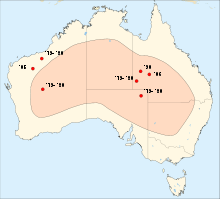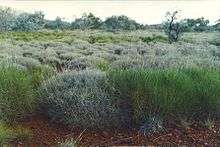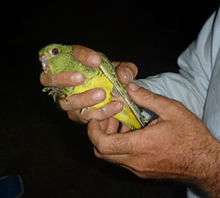Night parrot
| Night parrot | |
|---|---|
 | |
| Scientific classification | |
| Kingdom: | Animalia |
| Phylum: | Chordata |
| Class: | Aves |
| Order: | Psittaciformes |
| Family: | Psittaculidae |
| Tribe: | Pezoporini |
| Genus: | Pezoporus |
| Species: | P. occidentalis |
| Binomial name | |
| Pezoporus occidentalis (Gould, 1861) | |
 | |
| Historical (light red) and recent sightings with year (red dots) | |
| Synonyms | |
|
Geopsittacus occidentalis | |
The night parrot (Pezoporus occidentalis) is a small parrot endemic to the continent of Australia. It is well known as being one of the most elusive and mysterious birds in the world, with no known sightings of the bird between 1912 and 1979, leading to speculation that it was extinct. Sightings since 1979 have been extremely rare and the bird's population size is unknown, though based on the paucity of records it is thought to number between 50 and 249 mature individuals. The first photographic and video evidence of a live individual was publicly confirmed in July 2013. After 17,000 hours in the field and 15 years of searching, wildlife photographer John Young captured several photos and a 17-second video of the bird in western Queensland. In August 2015, the capture of a live individual was announced on Australian media.[2][3]
Taxonomy
Ornithologist John Gould described the night parrot in 1861,[4] from a specimen—the holotype—that was collected 13 km southeast of Mt Farmer, west of Lake Austin in Western Australia. Its specific epithet is Latin occidentalis "western". The species was originally placed within its own genus (Geopsittacus) by Gould,[5][6] though consensus soon swung in favour of placing it in Pezoporus; James Murie dissected a specimen, observing that it was very similar in anatomy and plumage to the ground parrot.[7] Gould had posited a relationship to the kakapo based on similarity of the plumage,[4] however Murie concluded they were markedly different anatomically.[7] Despite its close relationship with the ground parrot, its placement in the genus Pezoporus was uncertain, with some authorities leaving it in its own genus, as data on the night parrot was so limited. A 1994 molecular study using the cytochrome b of several parrot species confirmed the close relationship of the taxa and consensus for its placement in Pezoporus. It also revealed that the kakapo was not closely related to Pezoporus.[8] Analysis of mitochondrial and nuclear DNA sequences in a 2011 study showed that the night parrot most likely diverged from the ancestor of the eastern and western ground parrots around 3.3 million years ago.[9]
Alternate names include spinifex parrot, porcupine parrot, western ground parrot, nocturnal ground parakeet, midnight cockatoo and solitaire.[10]
Description
A relatively small and short-tailed parrot, the species' colour is predominantly a yellowish green, mottled with dark brown, blacks and yellows. Both sexes have this coloration. It is distinguished from the two superficially similar ground parrot species by its shorter tail and different range and habitat. Predominantly terrestrial, taking to the air only when panicked or in search of water, the night parrot has furtive, nocturnal habits and—even when it was abundant—was apparently a highly secretive species. Its natural habitat appears to be the spinifex grass which still dominates much of the dry, dusty Australian interior; other early reports also indicate that it never strayed far from water. It may also inhabit chenopod shrublands, eucalyptus woodlands, and mallee shrublands.
Diet

The night parrot eats seeds of grasses (especially Triodia) and herbs.
Conservation status
The population size of this species is not known. Estimates range from extinct to not threatened at all. As of 2012, it is listed on the IUCN Red List as Endangered, having previously been listed as Critically Endangered.[1] According to the IUCN Red List the night parrot has a population of 50–249 or possibly larger.[1] It is listed as Endangered under the Environment Protection and Biodiversity Conservation Act 1999 by the Australian government.[10]
The night parrot remains one of the most elusive and mysterious birds in the world of ornithology. Reliable records of the bird have been few and far between, with efforts to locate the species proving fruitless after an authenticated report from 1912.[8] Ornithologists continued to patrol the outback for traces, even checking the old nests of other birds, such as the zebra finch, for fragments of night parrot feathers.
In 1979, ornithologist Shane Parker from the South Australian Museum spotted an apparent flock of the birds in the far north of South Australia.[11] A roadkill specimen was discovered in 1990 by scientists returning from an expedition in a remote part of Queensland,[12][13] and three individuals were seen in 2005 near Minga Well, in the Pilbara region of Western Australia.[12][14]
Then, in 2006, rangers found a dead specimen which had flown into a barbed wire fence in the Diamantina National Park in south western Queensland.[12][15][16]
Modern sightings
Recent sightings of the bird:
- April 2005, Pilbara region of Western Australia and near the Fortescue Marshes[14]
- September 2006, dead female, Diamantina National Park.[17]
- May 2013, first photograph and video footage of a living specimen.[18][19] Subsequent DNA testing of feathers found confirms the find.[20]
- 2016, Young announced he had found a new population of night parrots in another part of Diamantina national park, the Pullen Pullen nature reserve. Seven sightings were recorded, including a pair and three active nests with eggs.[21][22]
Minga Well
The approval of the A$2 billion Cloud Break mine project through the then-Minister for the Environment, Ian Campbell, was criticised because of a number of endangered species in the area of the future mine, among them the night parrot.[23] In order to gain EPA approval, the mine had to implement a management plan to ensure that mining activities would not have a negative effect on the species survival in the area. The occurrence of the night parrot in the future mining area, at Minga Well on 12 April 2005, was discovered during a 2005 survey commissioned by FMG, which was carried out by two contract biologists who sighted a small group of the birds. Unconfirmed sightings of the bird had been made previously in a nearby area in 2004.[24][25]
The sighting, at dusk, was by biologists Dr Robert Davis and Mr Brendan Metcalf, who were not able to obtain a photograph of the three birds they saw, but are confident that they spotted three night parrots. The detailed descriptions of their sighting were accepted by the Birds Australia Rarities Committee (BARC) making it the first accepted night parrot sighting in modern times. Based on this acceptance by scientific peers, a paper describing the sighting was published in the Australian ornithological journal, Emu in 2008. The two biologists carried out further searches at Minga Well and Moojari Well the following five nights after the sighting, but were unable to see the birds again.[24] A follow up survey of the Fortescue Marsh area in May 2005 was unsuccessful in finding any conclusive evidence of the species.[26]
17-second video
In May 2013 wildlife cinematographer John Young, who made headlines in 2006 with an allegedly fake photo series of the blue-fronted fig parrot, had the opportunity to make the first ever photographs and video footage of a living specimen. He revealed his results during an invitation-only press conference on 3 July 2013,[27][28] but kept the exact range in Queensland where he had observed this individual secret to protect this species from poaching. Young provided five feathers from a roost site in the Lake Eyre basin to the Western Australian Museum's Molecular Systematics Unit, where DNA analysis conclusively matched the feathers to DNA samples of dead Pezoporus occidentalis birds.[29] Young declared that this was conclusive in establishing that the bird in his photographs and video is a night parrot.
Capture of live individual

On 4 April 2015, ornithologist Steve Murphy and partner Rachel Barr captured and radio tagged a live individual, whom they nicknamed "Pedro", in South-Western Queensland. Photographs of the bird in Murphy's hand were released to Australian media on 10 August 2015, while keeping the precise location secret.[2][3] A conservation reserve covering some 56,000 hectares has been created in the area to protect the species.[30]
Sean Dooley of Birdlife Magazine described the find as, "The bird watching equivalent of finding Elvis flipping burgers in an outback roadhouse". South Australian Museum collection manager Philippa Horton called the find, "One of the holy grails, one of the world's rarest species probably".[30]
Important Bird Areas
Sites identified by BirdLife International as being important for night parrot conservation are the Diamantina and Astrebla Grasslands of western Queensland, and the Fortescue Marshes of the Pilbara.[31]
References
- 1 2 3 BirdLife International (2013). "Pezoporus occidentalis". IUCN Red List of Threatened Species. Version 2013.2. International Union for Conservation of Nature. Retrieved 26 November 2013.
- 1 2 Milman, Oliver (10 August 2015). "Night parrot capture and tagging hailed as 'holy grail' moment for bird lovers". The Guardian. Guardian News and Media Limited. Retrieved 10 August 2015.
- 1 2 Grewal, Jessica (10 August 2015). "Looking for a night parrot in a haystack? Found one". The Australian. News Ltd. Retrieved 10 August 2015.
- 1 2 Gould, John (1861). "On a new genus and species of parakeet from Western Australia". Proceedings of the Zoological Society of London: 100–01.
- ↑ Forshaw, Joseph M. & Cooper, William T. (1981). Parrots of the World (3rd ed.). Willoughby, Australia: Press.
- ↑ Gould J. (1972) [1865]. Handbook to the Birds of Australia. London: Lansdowne Press.
- 1 2 Murie, James (1868). "On the nocturnal Ground Parakeet (Geopsittacus occidentalis Gould)". Proceedings of the Zoological Society of London: 158–65.
- 1 2 Leeton, Peter R. J.; Christidis, Leslie; Westerman, Michael & Boles, Walter E. (1994). "Molecular phylogenetic relationships of the Night Parrot (Geopsittacus occidentalis) and the Ground Parrot (Pezoporus wallicus)" (PDF). Auk. 111 (4): 833–43. doi:10.2307/4088815.
- ↑ Leo Joseph; Alicia Toon; Erin E. Schirtzinger; Timothy F. Wright (2011). "Molecular systematics of two enigmatic genera Psittacella and Pezoporus illuminate the ecological radiation of Australo-Papuan parrots (Aves: Psittaciformes)". Molecular Phylogenetics and Evolution. 59 (3): 675–684. doi:10.1016/j.ympev.2011.03.017. PMID 21453777.
- 1 2 Department of the Environment, Water, Heritage and the Arts (2008). "Pezoporus occidentalis — Night Parrot". Biodiversity: Species Profile and Threats Database. Australian Government. Retrieved 10 August 2015.
- ↑ John Blyth: Night Parrot (Pezoporus occidentalis) Interim Recovery Plan for Western Australia. 1996 to 1998. dec.wa.gov.au
- 1 2 3 Roberts, Greg: Bad news for one night parrot, good for species, The Australian, 16 February 2007. Retrieved 16 February 2007
- ↑ Boles, Walter E.; Longmore, N. W. & Thompson, M. C. (1994). "A Recent Specimen of the Night Parrot Geopsittacus occidentalis". Emu. 94 (1): 37–40. doi:10.1071/MU9940037.
- 1 2 Davis, Robert A.; Brenden M. Metcalf (2008). "The Night Parrot (Pezoporus occidentalis) in northern Western Australia: a recent sighting from the Pilbara region". Emu. 108 (3): 233–236. doi:10.1071/MU07058.
- ↑ "Twitchers cry foul in case of the deceased parrot". Brisbane Times. 2007-06-23. Retrieved 9 April 2008.
- ↑ Ex-parrot sighting in Qld sparks interest, Australian Broadcasting Corporation, 19 February 2007. Retrieved 19 February 2007
- ↑ Andrew McDougall; Gary Porter; Maree Mostert; Robert Cupitt; Sue Cupitt; Leo Joseph; Stephen Murphy; Heather Janetzki; Adrian Gallagher; Allan Burbidge (2009). "Another piece in an Australian ornithological puzzle – a second Night Parrot is found dead in Queensland". Emu. 109 (3): 198–203. doi:10.1071/MU08018.
- ↑ Tony, Koch (29 June 2013). "Is this a sighting of Australia's most elusive bird, the night parrot?". The Australian.
- ↑ Worthington, Elise (4 July 2013). "Queensland bird enthusiast presents museum with photos of elusive night parrot". ABC news. Retrieved 10 July 2015.
- ↑ DNA test confirms rare night parrot find
- ↑ O'Donnell, Jenna (1 November 2016). "Yes! More Australian Night Parrots Have Been Discovered". National Audubon Society. Retrieved 2016-11-02.
- ↑ Wahlquist, Calla (25 October 2016). "Night parrot population discovered in Queensland national park". The Guardian. Retrieved 2016-11-02.
- ↑ Campbell stands by Cloud Break mine approval ABC News, published: 24 July 2006, accessed: 9 November 2010
- 1 2 Management Plan EPA website, published: April 2005, accessed: 9 November 2010
- ↑ Pezoporus occidentalis — Night Parrot Department for Sustainability, Environment, Water, Population and Communities website, accessed: 9 November 2010
- ↑ FORTESCUE WETLANDS AREA, PRESENCE OF ENDANGERED SPECIES Parliamentary Question, Parliament of Western Australia, published: 8 November 2005, accessed: 9 November 2010
- ↑ Pickrell, John (3 July 2013). "Night parrot: tantalising clues revealed". Australian Geographic. Retrieved 4 July 2013.
- ↑ Leo Joseph (29 December 2013). "Found: world's most mysterious bird, but why all the secrecy?". The Conversation.
- ↑ "DNA confirms elusive Night Parrot found – Western Australian Museum". Western Australian Museum.
- 1 2 McLeish, Kathy (10 August 2015). "Night parrot conservation reserve created in Queensland for endangered and elusive bird". ABC News. Retrieved 10 August 2015.
- ↑ "Night Parrot". Important Bird Areas. BirdLife International. 2012. Archived from the original on July 10, 2007. Retrieved 2012-10-31.
Further reading
- Weidensaul, S. (2002). The Ghost with Trembling Wings: Science, Wishful Thinking, and the Search for Lost Species, North Point Press (New York), ISBN 0-86547-668-3, pp. 75–81.
External links
| Wikimedia Commons has media related to Pezoporus occidentalis. |
| Wikispecies has information related to: Pezoporus occidentalis |
- Night Parrot – Australian Museum
- Night Parrot Internet Bird Collection
- Night Parrot. Parrot Encyclopedia, World Parrot Trust
- Night Parrot Pezoporus occidentalis. BirdLife Species Factsheet, BirdLife International
